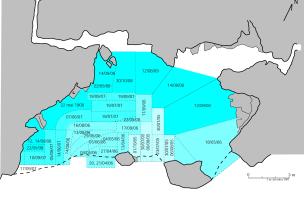You are here
Recent developments in the Aurignacian Culture at the Trou de la Mère Clochette
From 1905 to1909, Julien Feuvrier, a scholar from Dole, carried out rapid excavations in a modest cave in the Jura, known locally as the "Trou de la Mère Clochette", at Rochefort-sur-Nenon.
The prehistoric material found has since been kept in the Musèe des Beaux Arts of Dole. Today, three researchers, including Luc Jaccottey of Inrap, have just carried out new studies of these goods and have dated the oldest levels of the cave. These belong to the Proto-Aurignacian period, a culture of the first modern men in Western Europe, the Homo Sapiens. These results have now been published in the International Journal of Archaeological Science.
Excavations of a hundred years ago : 37 days for 35 000 years
Several thousand lithic pieces and bone tools were collected in the former context. They were reworked bladelets of the Dufour type, of bladelets core, of six "split-based” points of bone antler and ivory.
In 1907, the amateur archaeologist situated this industry in the Magdalenean culture (circa 17,000 to 11,000 BC) as he did not have, at that time, knowledge of the discoveries in Aurignac (Haute-Garonne), which brought to light the more ancient Upper Paleolithic culture, the Aurignacian.
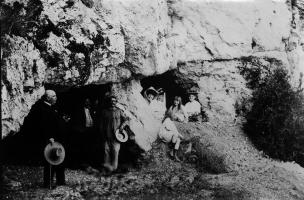
Fouille du Trou de la Mère Clochette à Rochefort-sur-Nenon, mai 1906 (Julien Feuvrier est adossé au pilier au centre de la photo).
Coll. Musée de Dole

Le Trou de la Mère Clochette à Rochefort-sur-Nenon, cliché J. Feuvrier, 1909.
Coll. Musée de Dole
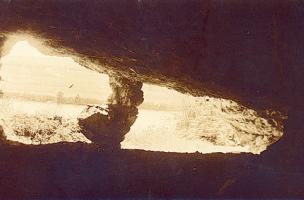
Vue de la vallée du Doubs depuis l’intérieur du Trou de la Mère Clochette à Rochefort-sur-Nenon, cliché J. Feuvrier 1909.
Coll. Musée de Dole
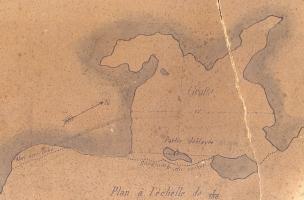
Plan de le Grotte du Trou de la Mère Clochette à Rochefort-sur-Nenon par J. Feuvrier.
Coll. Musée de Dole
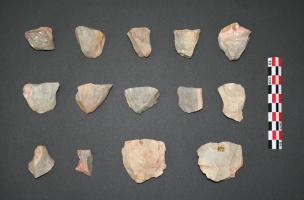
Trou de la Mère Clochette. (Proto)-Aurignacien, nucléus à lamelles en « chaille » du Bajocien.
Coll. Musée de Dole, cl. L. Brou
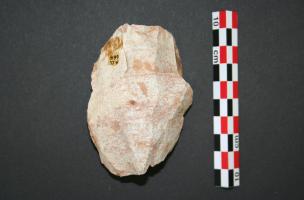
Trou de la Mère Clochette. (Proto)-Aurignacien, nucléus à lames en silex du Callovien.
Coll. Musée de Dole, cl. L. Brou
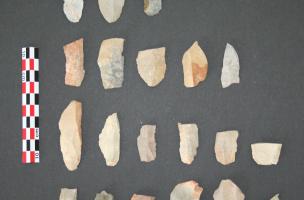
Trou de la Mère Clochette. (Proto)-Aurignacien, outils en « chaille » du Bajocien : grattoirs, burins, lames et éclats retouchés.
Coll. Musée de Dole, cl. L. Brou
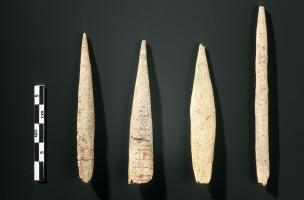
Trou de la Mère Clochette. (Proto)-Aurignacien, pointes à base fendue.
Coll. Musée de Dole, cl. L. Brou
The Aurignacians of the "Mère Clochette"
Situated in the Aurignacian period, the industries of the "Trou de la Mère Clochette" have been studied by Carolyn Szmidt, Laurent Brou and Luc Jaccotey. This deposit is henceforth one of the rare sites, with those of the caves of the "Renne" (Reindeer) and of the "Trilobite" at Arcy-sur-Cure (Yonne) and a few others in South Burgundy, which testify undeniably Aurignacian occupations in Northeastern France.
Prehistorians detect, above all in the lithic industry technology, the beginnings of this Aurignacian culture: the "Proto-Aurignacian”, which developed in western Mediterranean 38,000 to 34,000 years ago.
In order to obtain direct radiocarbon dating, two ochre-coloured bone fragments, "split-based points”, characteristic artefacts of this culture, were subjected to Accelerator Mass Spectometry (AMS) analysis in Oxford (United Kingdom).
If the first dating (circa 37,400 to 39,600 BP) is within chronological bracket of Classical Ancient Aurignacian, the other, much older, is clearly different (circa 40,000 to 41,000 BP).
Henceforth these two datings are now the oldest known for Aurignacian artefacts. These results thus give a basic point for the appearance of these "split-based points” wings, real "directive fossils” of this culture. Moreover, this illustrates the enormous capacity of technical innovation by the Aurignacians. These new datings of the "Trou de la Mère Clochette” could renew the models of prehistorians concerning the emergence of the "First Aurignacian” culture in Western Europe.
Szmidt, C.C., Brou, L., Jaccottey, L. 2010. « Direct radiocarbon (AMS) dating of split-based points from the (Proto) Aurignacian of Trou de la Mère Clochette, Northeastern France. Implications for the characterization of the Aurignacian and the timing of technical innovations in Europe ». Journal of Archaeological Science 37 (12), 3320-3337.
Carolyn Szmidt, Archaeology Centre, University of Toronto (Canada)
Laurent Brou, Service d’archéologie préhistorique, Musée national d’Histoire et d’Art (Luxembourg)
Luc Jaccottey, Inrap et laboratoire de Chrono environnement UMR 6249
Mahaut Tyrrell
Media communication
Inrap, media partnerships and relations department
01 40 08 80 24
mahaut.tyrrell [at] inrap.fr


